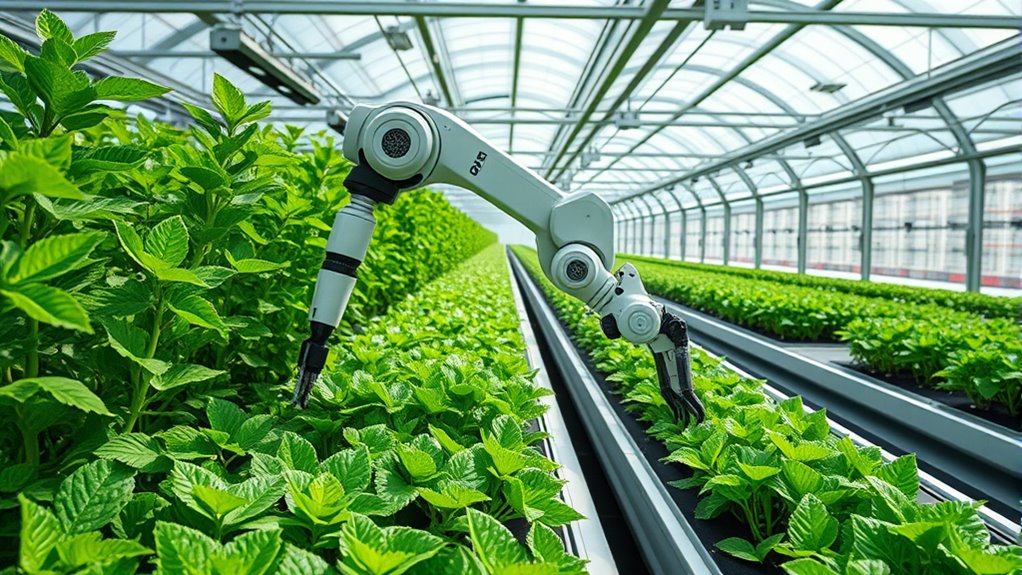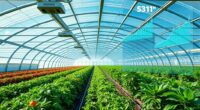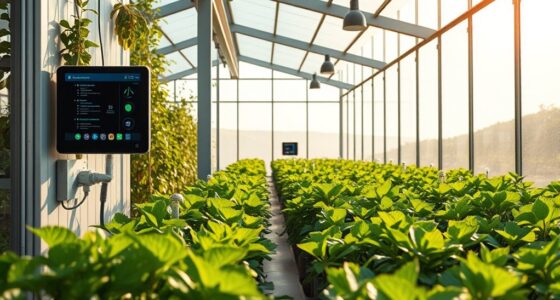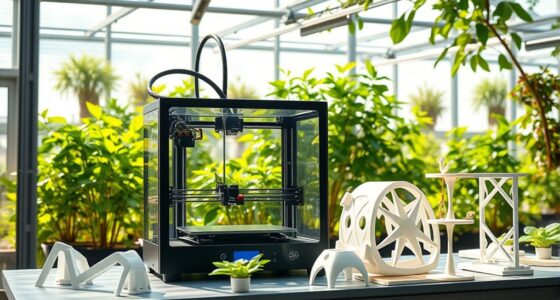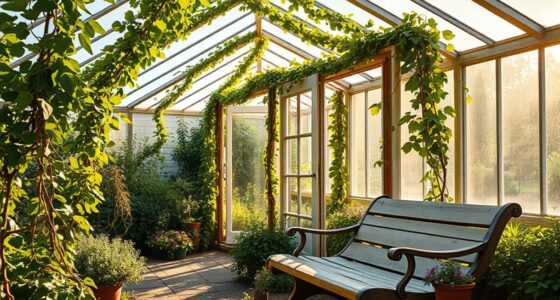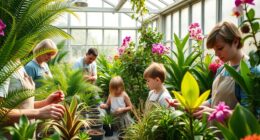Robotics in greenhouses are transforming agriculture by automating planting and harvesting with precise sensors and control systems. You can expect robots to handle seed placement accurately, monitor soil and climate conditions, and harvest crops efficiently without damage. These systems reduce labor costs and improve crop quality by maintaining ideal environments. If you keep exploring, you’ll discover how these innovations are creating smarter, more sustainable farming practices that can boost your productivity and success.
Key Takeaways
- Robots equipped with precision planting technology ensure accurate seed placement and optimal crop spacing.
- Automated harvesting systems identify ripe produce using visual cues and sensor data for efficient collection.
- Soil sensors enable robotic systems to adjust watering and nutrient delivery automatically for healthy growth.
- Climate control systems maintain ideal environmental conditions, enhancing crop quality and reducing resource waste.
- Integration of robotics increases scalability, reduces manual labor, and improves overall productivity in greenhouse farming.
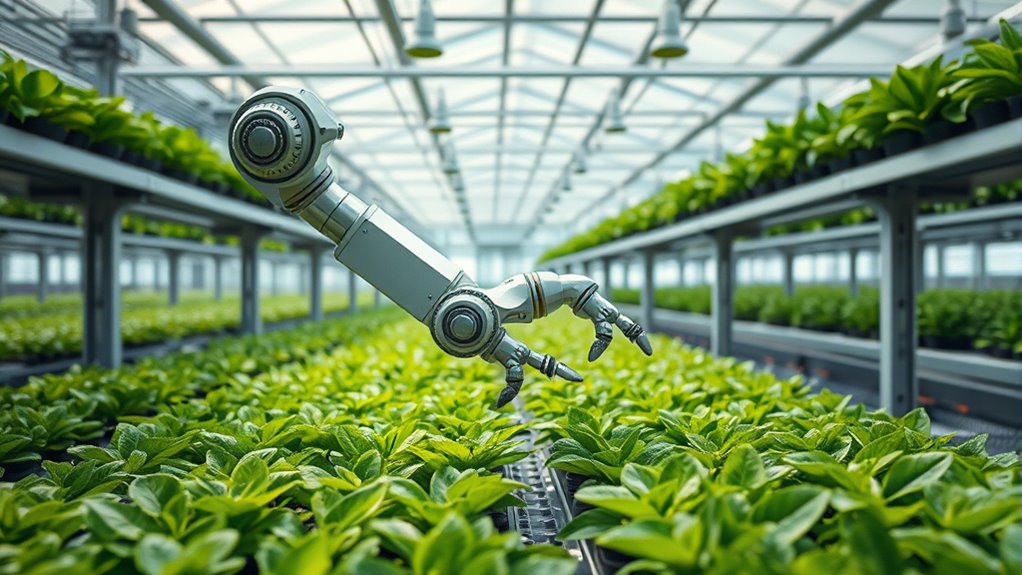
Have you ever wondered how robotics are transforming greenhouse agriculture? It’s a game-changer, especially when it comes to automating planting and harvesting processes. Robotics systems now integrate advanced technology like soil sensors and climate control to enhance plant growth and streamline operations. These innovations allow you to monitor and manage your greenhouse environment with precision, reducing waste and increasing yields. Soil sensors play a critical role by providing real-time data on moisture levels, nutrient content, and soil temperature. With this information, robotic systems can adjust watering schedules and nutrient delivery automatically, ensuring your plants get exactly what they need at the right time. This not only promotes healthier growth but also minimizes the risk of over- or under-watering, which can harm crops or waste resources. Implementing sensor-driven automation further enhances efficiency by enabling real-time adjustments based on sensor data. Climate control systems, integrated with robotics, further enhance this process by maintaining ideal temperature, humidity, and light conditions. Sensors feed data into automated controllers that adjust fans, heaters, and lighting, creating a stable environment tailored to each crop’s requirements. As a result, you can achieve consistent growing conditions, regardless of external weather fluctuations. When it’s time to plant, robots equipped with precision planting technology can handle seed placement with remarkable accuracy, ensuring proper spacing and depth. This reduces manual labor and improves germination rates. During harvest, robotic systems can identify ripe produce based on visual cues or sensor data, then carefully pick and package crops without damaging them. This automation speeds up the entire harvest process, allowing you to scale up production without a proportional increase in labor costs. Additionally, integrating advanced planning strategies can optimize overall farm management and resource allocation. The combination of soil sensors, climate control, and robotics creates a seamless ecosystem that continually monitors and adjusts the growing environment. It’s like having a team of expert gardeners working around the clock, but with greater consistency and efficiency. This technology also minimizes human error and enhances resource management, leading to cost savings and more sustainable practices. As you adopt robotics in your greenhouse, you’ll find that these systems not only improve productivity but also provide valuable insights into crop performance. Over time, data collected from sensors can help you refine your growing strategies, making your operation more resilient and profitable. Essentially, integrating robotics, soil sensors, and climate control transforms traditional greenhouse farming into a highly precise, automated system. It empowers you to produce healthier plants, optimize resource use, and meet growing demand with less effort. The future of greenhouse agriculture is here, and it’s driven by innovative robotics that make planting, caring for, and harvesting crops smarter and more efficient. Incorporating advanced technology in greenhouse systems can further enhance the overall efficiency and sustainability of your operation.
Frequently Asked Questions
What Are the Initial Costs of Implementing Greenhouse Robotics?
When you consider the initial costs of implementing greenhouse robotics, you should conduct a thorough cost analysis. These expenses include purchasing advanced technology, integrating systems, and training staff. Expect higher upfront investments for automation equipment, sensors, and software. While the initial costs can be significant, they often lead to long-term savings by increasing efficiency and reducing labor costs. Planning carefully helps balance investment with the benefits of automation.
How Do Robots Adapt to Different Crop Varieties?
Imagine a robot in a greenhouse that adjusts to different tomato varieties. It uses crop recognition to identify each plant and adaptive algorithms to modify its actions accordingly. These algorithms enable the robot to handle variations in size, shape, and growth patterns. By continuously learning from visual data, the robot optimizes harvesting and planting processes for diverse crop varieties, ensuring efficiency and precision across different plant types.
What Safety Measures Are in Place for Human-Robot Interaction?
You should know that safety measures for human-robot interaction focus on ensuring safe operations and preventing accidents. Human robot safety involves implementing interaction protocols like emergency stop buttons, safety barriers, and sensors that detect human presence. These protocols help create a secure environment where you can work alongside robots confidently. Regular training and clear signage also support safe human-robot collaboration, minimizing risks and promoting efficient, accident-free interactions.
How Do Robots Handle Unexpected Obstacles or Plant Issues?
Did you know that 85% of greenhouse robots use obstacle detection to navigate? When faced with unexpected obstacles or plant issues, robots rely on advanced sensors and plant health diagnostics to identify problems quickly. They adapt by rerouting or pausing operations, ensuring safety and precision. This real-time response minimizes crop damage, improves efficiency, and helps maintain healthy plants, even when surprises arise in the greenhouse environment.
What Is the Maintenance Requirement for Greenhouse Robotic Systems?
You need to regularly maintain your greenhouse robotic systems by performing robot calibration to guarantee precision and efficiency. Keep up with software updates to fix bugs and improve performance. Check for worn parts, clean sensors, and lubricate moving components to prevent breakdowns. Scheduling routine inspections helps catch issues early, minimizing downtime. Proper maintenance keeps your robots running smoothly, boosting productivity and ensuring the system operates accurately and reliably.
Conclusion
As you watch robots seamlessly tend to lush greenhouses, they transform the traditional farm into a futuristic landscape. The contrast between manual labor and automated precision highlights how technology reshapes agriculture’s future. While old-world farming relied on human effort, these robots bring efficiency and sustainability. Embrace this shift, blending innovation with nature, and picture a world where greenhouses flourish under the gentle hum of machines, nurturing crops with both care and intelligence.
